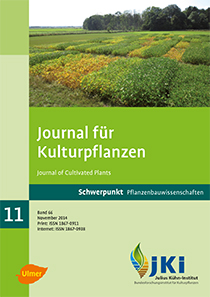Chilling tolerance in soybeans (<em>Glycine max</em>) – a prerequisite for soybean cultivation in Germany
Keywords:
Soybean, Glycine max L. (Merr.), chilling tolerance, podset, yield, protein contentAbstract
Besides advantages in crop rotations, soybeans are best suited for animal feed and human nutrition due to their protein content and composition. But, because of the limited adaptation to growing conditions, soybeans cannot be grown all over Germany mainly due to a lack of chilling tolerance, which is an important goal in soybean breeding in Germany therefore. In order to get information on the genetic variation of chilling tolerance in soybean, a test under controlled conditions was developed applying 15°C day/10°C night temperature for 3 weeks, which allows to get reliable information on pod set under cool conditions. Using this test, genotypes were identified revealing only a small reduction of the number of pods (chilling tolerance in the narrow sense), but also those compensating the loss of pods under cool conditions by a higher pod set in warmer conditions after the chilling period (tolerance in a broader sense). With respect to the latter also genotypic differences concerning the time to harvest were observed. Moreover, real sensitivity without compensation ability occurred. Responses of cultivars to a chilling period in the field trials of 2011 and 2013 showed a good correlation to the results obtained under controlled conditions. These field trials also demonstrated that soybean can be successfully grown even in Northern Germany, in case early ripening varieties (early 00–0000) are used. In this respect, higher yields of later ripening cultivars were observed in years with higher temperature sums while more stable yields but on a lower level were obtained by early ripening cultivars, where cultivars with high yield stability in general also showed a good chilling tolerance.
DOI: 10.5073/JfK.2014.11.02, https://doi.org/10.5073/JfK.2014.11.02
Downloads
Published
Issue
Section
License
The content of the journal is licensed under the Creative Commons Attribution 4.0 License. Any user is free to share and adapt (remix, transform, build upon) the content as long as the original publication is attributed (authors, title, year, journal, issue, pages).
The copyright of the published work remains with the authors. The authors grant the Journal of Cultivated Plants, the Julius Kühn-Institut and the OpenAgrar repository the non-exclusive right to distribute and exploit the work.







